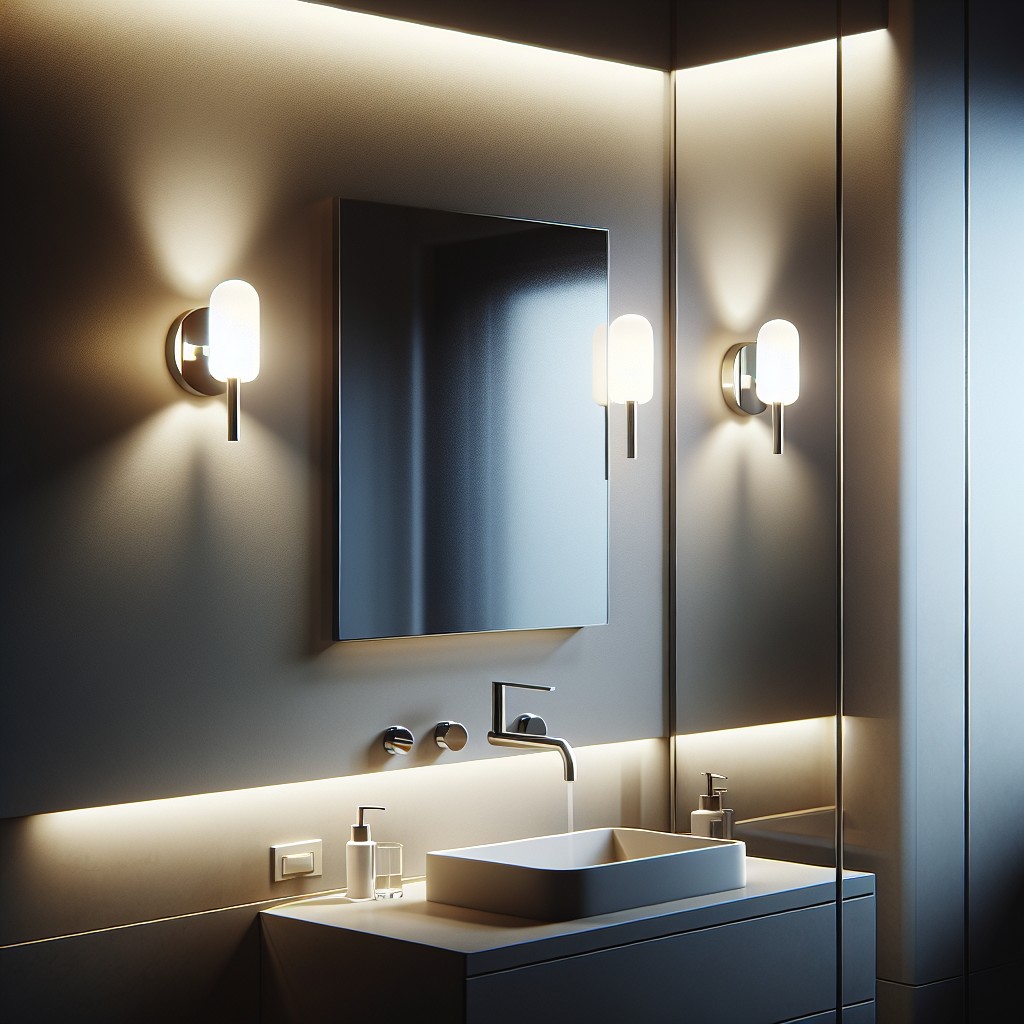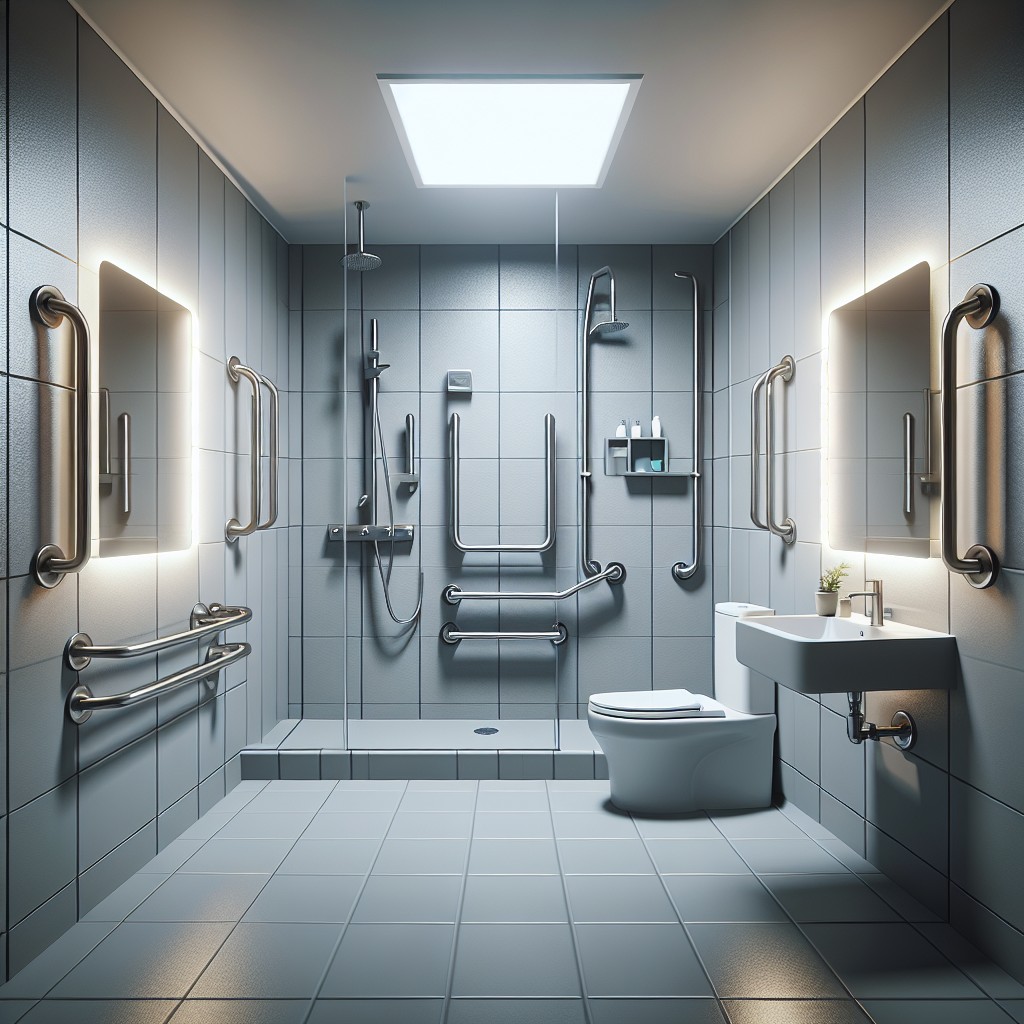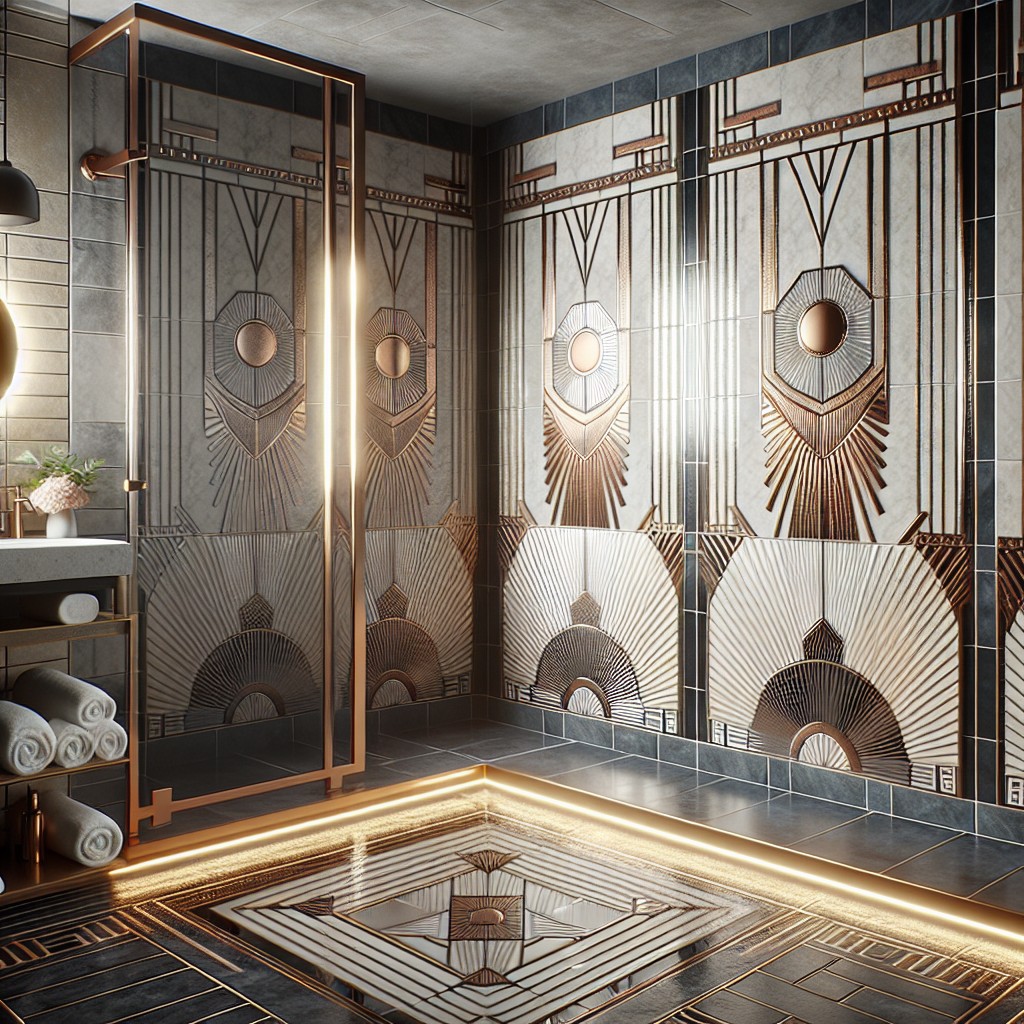Last updated on
Finding the ideal height for your bathroom sconces can greatly enhance your bathroom experience because it impacts both functionality and aesthetics – stick around for a comprehensive guide on determining the perfect sconce height for your bathroom.
Key takeaways:
- Proper illumination for grooming tasks
- Mount sconces at eye level for comfort
- Ensure sconces integrate with other elements for a cohesive look
- Install sconces at a safe height to prevent accidents
- Consider symmetry for a balanced aesthetic
What's Inside
Why Use Wall Sconces in a Bathroom?

Wall sconces are a blend of functionality and aesthetic appeal. They provide the necessary task lighting that is crucial for daily grooming rituals such as shaving or applying makeup. Sconces offer directional lighting, which minimizes shadows on the face. They are also versatile, available in a variety of styles to complement any bathroom decor from vintage to modern.
Moreover, sconces can contribute to the ambiance of the bathroom. Positioned at eye level, they create a welcoming and warm atmosphere, serving not just a practical purpose but also elevating the overall design of the space. Additionally, they are effective in smaller bathrooms where ceiling height or space limitations may not accommodate overhead lighting. Through the strategic use of sconces, you can achieve both superior lighting and an enhanced bathroom experience.
Why Does the Height of the Wall Sconce Matter With Vanity Lighting?

Selecting the optimal height for wall sconces in relation to vanity lighting is crucial for both functionality and aesthetics. Here’s why:
1. Proper Illumination: Wall sconces positioned at the correct height will cast light evenly across your face, reducing shadows and enhancing visibility – important for grooming tasks.
2. Eye-Level Comfort: Sconces set too high or too low can cause glare in your eyes or fail to sufficiently light the face. Generally, mounting them at eye level, which is typically around 60 to 70 inches from the floor, caters to both tall and short individuals.
3. Space Harmony: The right height ensures that the sconces visually integrate with the other elements in the room, such as the mirror, to create a cohesive look.
4. Safety Considerations: Properly installed sconces at a safe height prevent accidents and ensure they are out of the way of any bathroom moisture, which could be a potential hazard.
Understanding these points will guarantee your bathroom vanity area is both elegantly lit and functionally sound.
Consider the Bathroom Vanity Height
When selecting the perfect spot for your sconces, aligning them with the vanity is a balancing act. Typically, vanities stand around 30 to 34 inches tall. To ensure your lighting is ideally positioned, aim to mount the sconces at least 18-20 inches above the vanity top. This helps to cast light at a practical height, avoiding any awkward shadows or glare. Keep in mind, those of taller stature might want to adjust this height slightly upwards to match eye level. It’s about merging function with comfort to enhance your bathroom experience.
The Rule of Thumb for Placement of Wall Sconces
When positioning wall sconces beside a bathroom mirror, aim for an eye-level installation. This typically means mounting them about 65 to 70 inches from the floor to the center of the fixture. This height range accommodates most adults, ensuring that the light is directed properly without causing harsh shadows.
Should the bathroom serve multiple users of differing heights, choose a midpoint that offers balanced lighting for everyone. For bathrooms frequented by children, consider adjustable lighting or install at a standard height with the option to add a step stool.
Another factor is the placement relative to the mirror. Ideally, sconces should be placed around 28 to 30 inches apart, and if framing the mirror, around 6 to 8 inches from its edge. This setup provides even lighting across the face, minimizing shadows that can impede grooming tasks.
Remember these are guidelines, not steadfast rules. Bathroom configurations and personal use may lead to tailored adjustments.
Consider the Bathroom Mirror Size and Placement
When integrating sconces with your bathroom mirror, size and placement play pivotal roles in achieving a balanced look and optimal lighting. Here are key points to keep in mind:
- Align the top of the sconce with the upper edge of the mirror to create a clean, vertical line that enhances visual height.
- For larger mirrors, consider spacing sconces about 36 to 40 inches apart, which allows for even light distribution and reduced shadows.
- Position sconces at least 28 inches apart, centering them over the vanity to maintain focal balance and functionality.
- If the mirror is tall, mounting the sconces slightly off to the side prevents glare and reflection issues, ensuring a pleasant user experience.
- For mirrors that span the width of the vanity, avoid placing sconces too close to the mirror’s edge to prevent a cramped appearance.
These guidelines ensure that your mirror and sconces work together harmoniously, creating a well-lit and good-looking bathroom space.
Maintaining Symmetry With Bathroom Wall Sconces
Symmetry is key to creating a balanced, pleasant aesthetic in your bathroom. When placing wall sconces on either side of the mirror, ensure that they are at equal heights to achieve a harmonious look.
Here are a few points to keep in mind:
- Measure from the floor: Start by measuring an equal distance up from the floor to the bottom of each sconce, which provides a consistent baseline.
- Center with the mirror: Align the center of each sconce with the center height of the mirror to maintain visual equilibrium.
- Distance from the mirror edge: Keep the distance from the edges of the mirror to the sconces the same on both sides to enhance the symmetric effect.
- Equidistant from the sink: If the sconces flank a sink, they should be equidistant from the sink’s center to avoid a lopsided lighting setup.
By adhering to these symmetry guidelines, you’ll ensure that your bathroom lighting is both functional and aesthetically pleasing.
Final Touches and Personal Preferences
After nailing the functional aspects of bathroom sconce placement, inject your unique style into the space. Use dimmers for adjustable ambiance, particularly beneficial during relaxing baths or middle-of-the-night visits when bright lights can be jarring.
Play with different sconce designs that complement your decor—geometric for a modern look, or ornate fixtures for a classic feel. Experiment with bulb colors; warmer hues create a cozy atmosphere, while cooler tones mimic natural daylight.
Consider adding a small plant or a decorative element on the vanity to create harmony between the sconces. Remember, lighting should not only be practical, but it can also enhance the aesthetic and mood of your bathroom space.
How Bright Should Bathroom Sconces Be?
Optimal brightness for bathroom sconces enhances functionality and ambiance. Aim for a combined illumination of about 1,500 to 2,000 lumens for a standard-sized bathroom. This total includes all light sources. LED bulbs are a popular choice, offering a range of color temperatures from warm to cool light; typically, 2700K to 3000K is a comfortable range for the bathroom, providing a warm, inviting glow that accurately mirrors daylight. Adjustable dimmers also offer versatility, allowing you to adapt the lighting to the time of day or specific tasks like applying makeup or shaving, where clear, bright light is pivotal. Choose frosted or opal glass shades to diffuse light, reducing glare and creating an even light distribution. Remember, lighting is not just about functionality but also comfort and design, so consider how the brightness of your sconces will contribute to the overall atmosphere of your bathroom.
Should Bathroom Sconces Be Up or Down?
Choosing between upward or downward facing sconces hinges on a couple of key considerations – the type of ambiance you’re aiming for and the task at hand. If you’re looking for a soft, ambient glow that bounces off the ceiling and fills the room, then upward facing is the way to go. This is particularly ideal for a relaxing soak where harsh direct lighting isn’t necessary.
On the flip side, for tasks like shaving or applying makeup, downward facing sconces provide direct illumination without casting shadows, making it easier to see what you’re doing. It’s crucial to think about the design and functionality of the sconce itself, too. Some are specifically engineered to direct light in a particular way – always ensure their style aligns with your lighting needs.
It’s also worth noting that certain sconce designs are versatile, giving you the freedom to switch between upward and downward orientation. This provides flexibility to adjust the lighting according to different activities or desired atmospheres within your bathroom space.
How High Do You Install a Light Fixture Above a Mirror?
Ensuring the light fixture is appropriately positioned above a bathroom mirror is crucial for both functionality and aesthetics. Typically, you should mount the fixture about 75 to 80 inches from the floor to the center of the light fixture. This height prevents glare and shadows, allowing for optimal illumination when using the mirror.
If you have high ceilings, don’t be tempted to hang the fixture too high. Instead, maintain the recommended distance from the top of the mirror—about 6 to 8 inches—to keep the light balanced and focused where it’s needed.
For larger mirrors, consider using a longer fixture or multiple lights spread evenly across the width of the mirror. This ensures an even distribution of light, reducing harsh shadows that can affect grooming tasks.
Remember to factor in the size of the fixture itself. For fixtures with downward shades, the bottom should sit at eye level to prevent the light source from being directly visible, reducing the risk of discomfort or glare.
Adjust these guidelines as necessary to fit the specific layout and design of your bathroom, maintaining a harmony between functionality and design.
FAQ
How high should wall sconces be mounted in bathroom?
In bathroom settings, wall sconces should ideally be mounted at a height of 60-65 inches from the floor, which aligns with eye level, to avoid shadows or harsh glares.
Where should bathroom wall sconces be placed?
Bathroom wall sconces should ideally be mounted 36 to 40 inches apart on either side of the mirror, about 18 inches from the sink’s center line and, if they have shades, the bottom edges should be just below eye level, approximately 60 to 68 inches off the floor.
What is the best height for bathroom wall lights?
The ideal height for bathroom wall lights is approximately 152-170cm (around 5-5.5ft) above floor level, while if multiple lights are used, they should be positioned approximately 250-300cm (8-10ft) apart.
How high do you hang sconces next to a bathroom mirror?
Sconces next to a bathroom mirror should be mounted just above eye level, typically about 60"-65" from the floor to the center height of the sconce backplate.
What factors should be considered when determining the mounting height for bathroom sconces?
When determining the mounting height for bathroom sconces, factors to consider include the height of the people using the bathroom, the position of the mirror, the style and size of the sconces, and the overall aesthetics of the room.
Can the height of a bathroom vanity affect the placement of wall sconces?
Yes, the height of a bathroom vanity can impact the placement of wall sconces, as it influences the optimal height for lighting fixtures for proper illumination and aesthetics.
How does the layout of your bathroom determine the positioning of wall sconces?
The layout of your bathroom primarily determines the positioning of wall sconces, based on the location of the mirror and sink, ensuring optimal illumination and avoiding shadows or glare.




